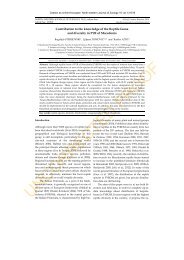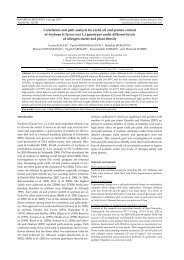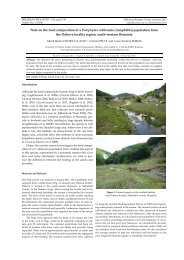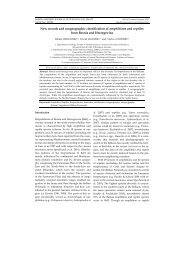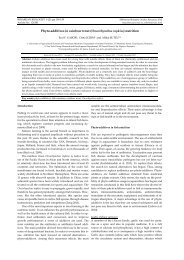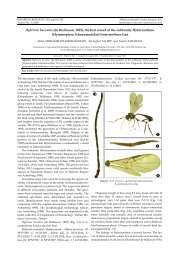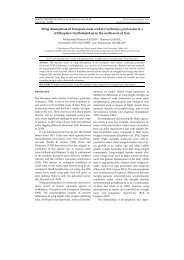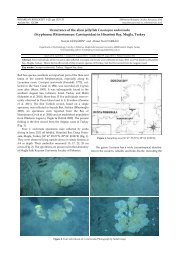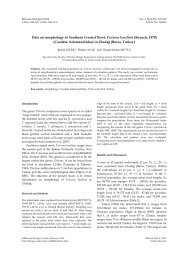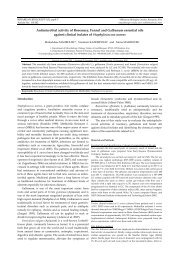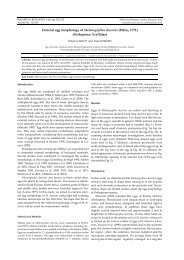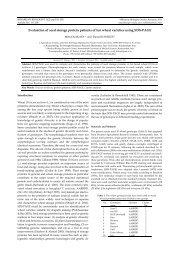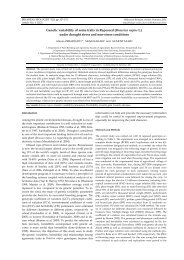Karyotypes of three gerbil species of the genera Tatera and ...
Karyotypes of three gerbil species of the genera Tatera and ...
Karyotypes of three gerbil species of the genera Tatera and ...
Create successful ePaper yourself
Turn your PDF publications into a flip-book with our unique Google optimized e-Paper software.
NORTH-WESTERN JOURNAL OF ZOOLOGY 9 (1): 57-62 ©NwjZ, Oradea, Romania, 2013<br />
Article No.: 131701 http://biozoojournals.3x.ro/nwjz/index.html<br />
<strong>Karyotypes</strong> <strong>of</strong> <strong>three</strong> <strong>gerbil</strong> <strong>species</strong> <strong>of</strong> <strong>the</strong> <strong>genera</strong> <strong>Tatera</strong> <strong>and</strong> Gerbilliscus<br />
from Turkey <strong>and</strong> Senegal<br />
Atilla ARSLAN 1, Jan ZIMA 2,*, Darina KOUBÍNOVÁ 3,<br />
Tarkan YORULMAZ 4, Kubilay TOYRAN 5 <strong>and</strong> Serdar GÖZÜTOK 6<br />
1. Department <strong>of</strong> Biology, Faculty <strong>of</strong> Science, Selçuk University, 42031 Konya, Turkey.<br />
2. Institute <strong>of</strong> Vertebrate Biology, Academy <strong>of</strong> Sciences <strong>of</strong> <strong>the</strong> Czech Republic, 603 65 Brno, Czech Republic.<br />
3. Department <strong>of</strong> Zoology, Faculty <strong>of</strong> Science, Charles University, 128 44 Praha, Czech Republic.<br />
4. Department <strong>of</strong> Biology, Faculty <strong>of</strong> Science, Çankırı Karatekin University, Çankırı, Turkey.<br />
5. Department <strong>of</strong> Biology, Faculty <strong>of</strong> Science <strong>and</strong> Arts, Bitlis Eren University, Bitlis Turkey.<br />
6. Department <strong>of</strong> Biology, Faculty <strong>of</strong> Science <strong>and</strong> Arts, Kırıkkale University, 71450 Kırıkkale, Turkey.<br />
*Corresponding author, J. Zima, e-mail: jzima@brno.cas.cz<br />
Received: 11. November 2011 / Accepted: 05. November 2012 / Available online: 27. December 2012 / Printed: June 2013<br />
Abstract. In this study, we examined karyotypes <strong>of</strong> <strong>three</strong> <strong>gerbil</strong> <strong>species</strong> <strong>of</strong> <strong>the</strong> <strong>genera</strong> <strong>Tatera</strong> <strong>and</strong> Gerbilliscus.<br />
The diploid number <strong>of</strong> 68 chromosomes was confirmed in all specimens <strong>of</strong> <strong>Tatera</strong> indica examined from<br />
sou<strong>the</strong>astern Anatolia in Turkey. The C-b<strong>and</strong> positive regions were distributed in centromeric areas <strong>of</strong> all <strong>the</strong><br />
autosomal pairs <strong>and</strong> <strong>the</strong> X chromosome. The Y chromosome was stained uniformly <strong>and</strong> C-positively. The<br />
active NORs were localized in <strong>three</strong> out <strong>of</strong> eight pairs <strong>of</strong> biarmed autosomes (NF=86). Conventionally stained<br />
karyotypes were studied in two <strong>species</strong> <strong>of</strong> Gerbilliscus from Senegal, western Africa. The female karyotype <strong>of</strong><br />
G. gambianus contained 52 chromosomes including one large subtelocentric, six submetacentric <strong>and</strong> 19<br />
acrocentric pairs (NF=66). The female karyotype <strong>of</strong> G. guineae contained 50 chromosomes including a large<br />
metacentric, eight submetacentric <strong>and</strong> 16 acrocentric autosomal pairs (NF=68). Minor differences in<br />
chromosome morphology were observed in <strong>the</strong>se studied <strong>species</strong> in comparison with previously published<br />
data.<br />
Keywords: cytogenetics, taxonomy, Gerbillinae, Asia Minor, western Africa.<br />
Introduction<br />
The <strong>gerbil</strong>s (Muridae: Gerbillinae) represent a<br />
distinct group defined by a set <strong>of</strong> derived morphological<br />
traits (Musser & Carleton 2005). Pavlinov et<br />
al. (1990) recognized two lineages <strong>of</strong> extant <strong>gerbil</strong><br />
<strong>species</strong> designated as Taterillinae <strong>and</strong> Gerbillinae.<br />
The <strong>genera</strong> <strong>Tatera</strong> <strong>and</strong> Gerbilliscus, previously<br />
considered congeneric, were included in <strong>the</strong> former<br />
lineage. Pavlinov et al. (1990) <strong>and</strong> Pavlinov<br />
(2001) regarded true <strong>Tatera</strong> to consist only <strong>of</strong> single<br />
Asian <strong>species</strong>, <strong>and</strong> separated <strong>the</strong> African endemic<br />
genus Gerbilliscus, with Taterillus as its closest<br />
relative. The Asian <strong>Tatera</strong> <strong>and</strong> African Gerbilliscus<br />
are differentiated by certain morphological traits<br />
(Musser & Carleton, 2005), <strong>and</strong> also karyotypes<br />
(Rao et al. 1968, Yosida 1981, Qumsiyeh <strong>and</strong><br />
Schlitter 1991, Yiğit et al. 2001). Cytogenetic data<br />
for <strong>gerbil</strong>s were summarized by Viegas-Péquinot<br />
et al. (1986) <strong>and</strong> Qumsiyeh & Schlitter (1991).<br />
The Indian <strong>gerbil</strong>, T. indica (Hardwicke, 1807)<br />
occurs from Mesopotamia across Iran, Afghanistan,<br />
<strong>and</strong> Pakistan to India <strong>and</strong> Sri Lanka. The<br />
<strong>species</strong> is known from south-eastern Turkey in <strong>the</strong><br />
area between Akçakale <strong>and</strong> Ceylanpınar (in Şanlıurfa),<br />
close to <strong>the</strong> Syrian border (Kryštufek &<br />
Vohralík 2009). A number <strong>of</strong> dispersed karyotypic<br />
data has been obtained by Mat<strong>the</strong>y (1953), Rao et<br />
al. (1968), Aswanthanaryana <strong>and</strong> Manjunatha<br />
(1981), <strong>and</strong> Yosida (1981). In Turkey, <strong>the</strong> conventionally<br />
stained karyotype <strong>of</strong> T. indica was described<br />
by Yiğit et al. (2001) from Ceylanpınar.<br />
However, information on differentially stained<br />
chromosomes <strong>and</strong> detailed structure <strong>of</strong> <strong>the</strong> karyotype<br />
is still lacking in this <strong>species</strong>.<br />
The genus Gerbilliscus, previously included as<br />
a part <strong>of</strong> <strong>the</strong> <strong>Tatera</strong> genus, consists <strong>of</strong> about 11<br />
<strong>species</strong>. The western Africa Gerbilliscus <strong>species</strong><br />
reveal a relatively high level <strong>of</strong> karyotype variability<br />
(Colangelo et al. 2001, Volobouev et al. 2007).<br />
The <strong>species</strong> studied by us belong to wellsupported<br />
western clade including G. gambianus,<br />
G. guineae, G. kempi, <strong>and</strong> possibly o<strong>the</strong>r not yet<br />
described <strong>species</strong> (Colangelo et al. 2007, Volobouev<br />
et al. 2007). The nor<strong>the</strong>rn savanna <strong>gerbil</strong>, G.<br />
gambianus (Wroughton, 1906) was listed as G.<br />
kempi by Musser <strong>and</strong> Carleton (2005) but <strong>the</strong> <strong>species</strong><br />
nomenclature was revised <strong>and</strong> proposed to be<br />
changed by Colangelo et al. (2007) <strong>and</strong> Volobouev<br />
et al. (2007). The <strong>species</strong> is distributed in a vast<br />
range throughout Sub-Saharan nor<strong>the</strong>rn savanna<br />
from western to eastern Africa. The karyotype was<br />
studied from Senegal, Niger, Chad, <strong>and</strong> Mali<br />
(Mat<strong>the</strong>y 1969, Hubert et al. 1973, Dobigny et al.
58<br />
2002, Granjon & Dobigny 2003, Volobouev et al.<br />
2007). The diploid number <strong>of</strong> 52 chromosomes<br />
was uniformly reported. The Guinean <strong>gerbil</strong>, G.<br />
guineae (Thomas, 1910), with <strong>the</strong> partly sympatric<br />
range, was recorded from Gambia <strong>and</strong> Senegal<br />
through Guinea, Sierra Leone, <strong>and</strong> sou<strong>the</strong>rn Mali<br />
to Burkina Faso <strong>and</strong> Ghana (Musser <strong>and</strong> Carleton<br />
2005). The karyotype <strong>of</strong> this <strong>species</strong> was examined<br />
in Burkina Faso <strong>and</strong> Mali (Mat<strong>the</strong>y & Petter 1970,<br />
Benazzou et al. 1984, Volobouev et al. 2007) <strong>and</strong><br />
<strong>the</strong> chromosome diploid number <strong>of</strong> 2n=50 was<br />
reported. Colangelo et al. (2001) <strong>and</strong> Volobouev et<br />
al. (2007) performed comparative chromosome<br />
b<strong>and</strong>ing analyses <strong>of</strong> <strong>the</strong> western African <strong>gerbil</strong>s <strong>of</strong><br />
<strong>the</strong> genus Gerbilliscus.<br />
The aim <strong>of</strong> this study is to evaluate chromosomal<br />
differences between <strong>the</strong> two <strong>genera</strong> studied,<br />
<strong>and</strong> to contribute to karyotype faunistic mapping<br />
<strong>of</strong> <strong>the</strong> <strong>three</strong> <strong>species</strong> examined. In this respect, this<br />
study is continuation <strong>of</strong> our survey <strong>of</strong> cytogenetic<br />
characteristics <strong>of</strong> mammals from Asia Minor <strong>and</strong><br />
western Africa (Koubínová et al. 2010, Arslan &<br />
Zima 2011, Arslan et al. 2011a,b). Chromosomal<br />
b<strong>and</strong>ing analysis <strong>of</strong> <strong>the</strong> karyotype <strong>of</strong> T. indica with<br />
<strong>the</strong> use <strong>of</strong> C-b<strong>and</strong>ing <strong>and</strong> Ag-NOR staining is<br />
aimed to facilitate fur<strong>the</strong>r comparative cytogenetic<br />
studies among <strong>gerbil</strong>s.<br />
Materials <strong>and</strong> methods<br />
The specimens <strong>of</strong> T. indica (6 males <strong>and</strong> 4 females) were<br />
collected in <strong>the</strong> Ceylanpinar, Şanlıurfa Province, sou<strong>the</strong>astern<br />
Turkey (36° 51´ N, 40° 04´ E). Single female <strong>of</strong> G.<br />
gambianus was collected in Diala Koto, south-eastern<br />
Senegal (13°18´ N, 13°16´ E). Two females <strong>of</strong> G. guineae<br />
originated from Dar Salam, Senegal (13°16´ N, 13°12´ E).<br />
All <strong>the</strong> animals were collected with <strong>the</strong> permission <strong>and</strong><br />
under supervision <strong>of</strong> <strong>the</strong> Senegal’s National Parks General<br />
Management.<br />
Karyotype preparations were obtained from <strong>the</strong> bone<br />
marrow <strong>of</strong> animals treated with colchicine (Ford <strong>and</strong><br />
Hamerton 1956). After preparation <strong>of</strong> chromosome slides,<br />
conventional Giemsa-staining was carried out. In T. indica,<br />
constitutive heterochromatin <strong>and</strong> nucleolus organizer<br />
regions (NORs) were detected in individual autosomal<br />
<strong>and</strong> sex chromosome pairs via C-b<strong>and</strong>ing (Sumner<br />
1972) <strong>and</strong> Ag-NOR staining (Howell <strong>and</strong> Black 1980),<br />
respectively. From each specimen, 4 to 20 slides were<br />
prepared, <strong>and</strong> at least 20 well-spread metaphase plates<br />
were analysed.<br />
St<strong>and</strong>ard voucher specimens (skins <strong>and</strong> skulls) are<br />
deposited in collections <strong>of</strong> <strong>the</strong> Department <strong>of</strong> Biology,<br />
Faculty <strong>of</strong> Science, Selçuk University, Konya, Turkey (T.<br />
indica), <strong>and</strong> <strong>the</strong> Institute <strong>of</strong> Vertebrate Biology ASCR,<br />
Brno, Czech Republic (Gerbilliscus spp. )<br />
Results<br />
A. Arslan et al.<br />
The karyotype <strong>of</strong> T. indica consists <strong>of</strong> 68 chromosomes<br />
including eight bi-armed pairs <strong>and</strong> 25 acrocentric<br />
pairs <strong>of</strong> autosomes (NFa = 82). The X<br />
chromosome is large <strong>and</strong> metacentric, while <strong>the</strong> Y<br />
chromosome is small acrocentric (NF = 86) (Fig. 1).<br />
The C-b<strong>and</strong>ed karyotype <strong>of</strong> this <strong>species</strong> is illustrated<br />
in Fig. 2. Most <strong>of</strong> <strong>the</strong> autosomes possess<br />
distinct pericentromeric C-b<strong>and</strong>s. The X chromosome<br />
has a centromeric C-positive b<strong>and</strong> <strong>and</strong> <strong>the</strong> Y<br />
chromosome appears to be uniformly <strong>and</strong> Cpositively<br />
stained. By using silver-nitrate staining,<br />
NORs are localized in <strong>the</strong> secondary constrictions<br />
in <strong>the</strong> short arms <strong>of</strong> <strong>the</strong> <strong>three</strong> bi-armed pairs (nos.<br />
1, 2, <strong>and</strong> 4). All <strong>the</strong> observed NORs are homomorphic<br />
<strong>and</strong> occur in both <strong>the</strong> homologues (Fig. 3).<br />
The female karyotype <strong>of</strong> G. gambianus (Fig. 4)<br />
consists <strong>of</strong> 52 chromosome that can be differentiated<br />
into one large subtelocentric pair, six medium-sized<br />
<strong>and</strong> small submetacentric pairs, <strong>and</strong> 19<br />
acrocentric pairs (NF=66). The largest subtelocentric<br />
pair can be tentatively designated as <strong>the</strong> X<br />
chromosomes (NFa=62), based on <strong>the</strong> comparison<br />
with o<strong>the</strong>r published data.<br />
The female karyotype <strong>of</strong> G. guineae (Fig. 5)<br />
consists <strong>of</strong> 50 chromosomes including single large<br />
metacentric pair, eight submetacentric pairs, <strong>and</strong><br />
16 acrocentric pairs (NF=68). The largest metacentric<br />
pair can be tentatively designated as <strong>the</strong> X<br />
chromosomes considering <strong>the</strong> published data on<br />
karyotypes <strong>of</strong> <strong>the</strong> <strong>species</strong>. Consequently, NFa is<br />
64.<br />
Discussion<br />
Aside from <strong>the</strong> distinct karyotypic differences<br />
between <strong>the</strong> <strong>genera</strong> <strong>Tatera</strong> <strong>and</strong> Gerbilliscus, which<br />
play a role in <strong>the</strong> generic division, <strong>the</strong>se <strong>species</strong><br />
share common features which well illustrate <strong>the</strong>ir<br />
common belonging to a clade based on mt DNA<br />
data (Colangelo et al. 2007). Contrary to differences<br />
in <strong>the</strong>ir number <strong>of</strong> chromosomal arms (86 in<br />
<strong>Tatera</strong> vs. 60-68 in Gerbilliscus, cf. Qumsiyeh <strong>and</strong><br />
Schlitter 1991, Volobouev et al. 2007), <strong>the</strong>re is a<br />
similar proportion <strong>of</strong> bi-armed <strong>and</strong> uni-armed<br />
autosomes, as well as <strong>the</strong> large X chromosomes<br />
which usually represent <strong>the</strong> largest elements <strong>of</strong> <strong>the</strong><br />
complement. Both <strong>the</strong> studied <strong>species</strong> <strong>of</strong> Gerbilliscus<br />
have similar karyotypes that differ in <strong>the</strong> centromere<br />
position on <strong>the</strong>ir largest chromosome<br />
(presumably <strong>the</strong> X chromosome) <strong>and</strong> in <strong>the</strong> pro-
<strong>Karyotypes</strong> <strong>of</strong> <strong>gerbil</strong>s<br />
Figure 1. Metaphase spread <strong>and</strong> male karyotype <strong>of</strong> <strong>Tatera</strong> indica (Turkey).<br />
Figure 2. Metaphase spread <strong>and</strong> C-b<strong>and</strong>ed male karyotype <strong>of</strong> <strong>Tatera</strong> indica.<br />
portion <strong>of</strong> <strong>the</strong> bi-armed <strong>and</strong> uni-armed chromosomes.<br />
An autosomal fusion may be assumed as a<br />
mechanism <strong>of</strong> divergence between <strong>the</strong> autosomal<br />
complements <strong>of</strong> both <strong>the</strong> <strong>species</strong> (Volobouev et al.<br />
2007). The b<strong>and</strong>ing analyses showed that <strong>the</strong><br />
variation in <strong>the</strong> morphology <strong>of</strong> <strong>the</strong> X chromosome<br />
may be related to a pericentric inversion (Colan-<br />
gelo et al. 2001).<br />
Certain differences can be found between <strong>the</strong><br />
results reported in this study <strong>and</strong> published records<br />
in individual <strong>species</strong>. Mat<strong>the</strong>y (1953) reported<br />
diploid number <strong>of</strong> 72 chromosomes, <strong>and</strong><br />
fundamental number <strong>of</strong> 80 chromosomal arms in<br />
T. indica. Different findings were reported by Rao<br />
59
60<br />
Figure 3. Silver-stained metaphase spread <strong>and</strong> male karyotype <strong>of</strong> <strong>Tatera</strong> indica.<br />
Arrows indicate <strong>the</strong> position <strong>of</strong> active Ag-NORs.<br />
Figure 4. Metaphase spread <strong>and</strong> female karyotype <strong>of</strong> Gerbilliscus gambianus (Senegal).<br />
et al (1968), Yosida (1981), <strong>and</strong> Aswanthanaryana<br />
<strong>and</strong> Manjunatha (1981) from India who found 2n<br />
= 68 in <strong>the</strong> somatic cells <strong>of</strong> <strong>the</strong> <strong>species</strong>. Aswanthanaryana<br />
<strong>and</strong> Manjunatha (1981) fur<strong>the</strong>r reported<br />
variation in <strong>the</strong> number <strong>of</strong> chromosomal<br />
A. Arslan et al.<br />
arms (NF = 80-86) in <strong>the</strong> Indian sub<strong>species</strong> T. indica<br />
hardwickei. Yosida (1981) described <strong>the</strong> karyotype<br />
containing eight bi-armed <strong>and</strong> 25 acrocentric<br />
autosomal pairs (NF=86 <strong>and</strong> NFa=82), a large <strong>and</strong><br />
metacentric X chromosome, <strong>and</strong> an acrocentric Y
<strong>Karyotypes</strong> <strong>of</strong> <strong>gerbil</strong>s<br />
Figure 5. Metaphase spread <strong>and</strong> female karyotype <strong>of</strong> Gerbilliscus guineae (Senegal).<br />
chromosome as in our case. Rao et al (1968) recorded<br />
NF= 84 <strong>and</strong> NFa= 80 in <strong>the</strong> sub<strong>species</strong> T.<br />
indica cuverii, <strong>and</strong> <strong>the</strong> same fundamental numbers<br />
were reported in populations examined from Turkey<br />
(Yiğit et al. 2001). The differences between<br />
published data are <strong>the</strong>refore caused by variable<br />
proportion <strong>of</strong> <strong>the</strong> bi-armed <strong>and</strong> uni-armed autosomes<br />
reported in individual papers. However,<br />
this variation reveals no clear geographical pattern,<br />
<strong>and</strong> could be influenced by varying interpretation<br />
<strong>of</strong> individual authors.<br />
According to Yosida (1981), almost all autosomes<br />
<strong>of</strong> Indian <strong>gerbil</strong> had a small centromeric Cb<strong>and</strong>,<br />
<strong>and</strong> <strong>the</strong> X <strong>and</strong> Y chromosomes were ra<strong>the</strong>r<br />
uniformly stained. The whole body <strong>of</strong> <strong>the</strong> Y chromosome<br />
was always stained heavily, but <strong>the</strong> Cstaining<br />
pattern <strong>of</strong> <strong>the</strong> X was somewhat variable.<br />
In most cells, both arms <strong>of</strong> <strong>the</strong> X were also intensively<br />
stained. This pattern <strong>of</strong> C-b<strong>and</strong>ing is congruent<br />
with our findings in <strong>the</strong> autosomal complement<br />
but certain differences are indicated in<br />
staining <strong>of</strong> <strong>the</strong> X chromosome. Similar C-b<strong>and</strong>ing<br />
pattern with <strong>the</strong> positive regions in centromeric<br />
position in all autosomes was recorded also in <strong>the</strong><br />
Gerbilliscus <strong>species</strong> (Colangelo et al. 2001, Volobouev<br />
et al. 2007). There are only few data about<br />
<strong>the</strong> distribution <strong>of</strong> NORs in <strong>the</strong> karyotype <strong>of</strong> <strong>gerbil</strong>s.<br />
Colangelo et al. (2001) reported <strong>the</strong> maximum<br />
number <strong>of</strong> four NORs in G. kempi. Similarly as in<br />
T. indica, <strong>the</strong>se NORs were located in telomeric<br />
position on biarmed autosomes.<br />
Chromosomal studies <strong>of</strong> G. gambianus from<br />
various parts <strong>of</strong> western Africa (Mat<strong>the</strong>y & Petter<br />
1970, Hubert et al. 1973, Dobigny et al. 2002, Granjon<br />
& Dobigny 2003) revealed similar results as<br />
those reported in this paper, but a different number<br />
<strong>of</strong> autosomal arms was recorded. The complement<br />
described in this study contains seven biarmed<br />
autosomal pairs (NFa=62) compared to<br />
eight bi-armed pairs reported in o<strong>the</strong>r studies<br />
(NFa=64). This difference may be related to autosomal<br />
heteromorphism recorded in a bi-armed<br />
pair in certain Gerbilliscus <strong>species</strong> from western<br />
Africa (Colangelo et al. 2001, Volobouev et al.<br />
2007). However, <strong>the</strong> homologous chromosomes in<br />
this heteromorphic pair were usually bi-armed<br />
(Volobouev et al. 2007), <strong>and</strong> <strong>the</strong> exact mechanism<br />
<strong>of</strong> <strong>the</strong> observed variation thus remains unknown.<br />
Certain differences between <strong>the</strong> published results<br />
can be found also in <strong>the</strong> centromere position in <strong>the</strong><br />
X chromosome (e. g., Mat<strong>the</strong>y & Petter 1970),<br />
however, <strong>the</strong>se differences may be explained by<br />
presumed misidentification <strong>of</strong> <strong>the</strong> sex chromosomes<br />
(Volobouev et al. 2007).<br />
The data on <strong>the</strong> karyotype <strong>of</strong> G. guineae (Mat<strong>the</strong>y<br />
& Petter 1970, Benazzou et al. 1984, Volobouev<br />
et al. 2007) are similar to <strong>the</strong> results reported<br />
in this paper (2n=50, NF=68, NFa=64). We<br />
61
62<br />
can conclude that minor differences in <strong>the</strong> karyotype<br />
structure may be revealed within individual<br />
<strong>Tatera</strong> <strong>and</strong> Gerbilliscus <strong>species</strong> provided that dense<br />
geographical sampling is available.<br />
Acknowledgements. We are obliged to thank J. Bryja, A.<br />
Konečný, <strong>and</strong> P. Koubek for providing materials from<br />
Senegal. The research in Senegal was supported by grants<br />
IAA 6093404 (Grant Agency AS CR), LC 06073 (Ministry<br />
<strong>of</strong> Education <strong>of</strong> <strong>the</strong> CR), <strong>and</strong> SVV-2012. 265 206 (Charles<br />
University).<br />
References<br />
Arslan, A., Şükrüye, A., Zima, J. (2011a): Variation in Cheterochromatin<br />
<strong>and</strong> NORs distribution among chromosomal<br />
races <strong>of</strong> mole rats (Spalacidae) from Central Anatolia, Turkey.<br />
Mammalian Biology 76: 28-35.<br />
Arslan, A., Yorulmaz, Y., Toyran, K., Gözütok, S., Zima, J. (2011b):<br />
C-heterochromatin variation <strong>and</strong> NOR distribution in <strong>the</strong><br />
karyotype <strong>of</strong> water vole, Arvicola terrestris (Mammalia,<br />
Rodentia). Caryologia 64: 213-220.<br />
Arslan, A., Zima, J. (2011): B<strong>and</strong>ed karyotype <strong>of</strong> <strong>the</strong> Konya wild<br />
sheep (Ovis orientalis anatolica Valenciennes, 1856) from Turkey.<br />
Comparative Cytogenetics 5: 81-89.<br />
Aswanthanaryana, N.V., Manjunatha, K.R. (1981): Studies on <strong>the</strong><br />
chromosomes <strong>of</strong> <strong>the</strong> genus <strong>Tatera</strong>. A preliminary report on <strong>the</strong><br />
occurrence <strong>of</strong> autosomal polymorphism in <strong>the</strong> Indian <strong>gerbil</strong>,<br />
<strong>Tatera</strong> indica hardwickei (Gray). Mammalian Chromosomes<br />
Newsletter 22: 52-53.<br />
Benazzou, T., Viegas-Péquignot, E., Prod’Homme, M., Lombard,<br />
M., Petter, F., Dutrillaux, B. (1984): Phylogénie chromosomique<br />
des Gerbillidae. III. Etudes des genres <strong>Tatera</strong>, Taterillus,<br />
Psamommys et Pachyuromys. Annales de Génétique 27: 17-26.<br />
Colangelo, P., Civitelli, M.V., Capanna, E. (2001): Morphology <strong>and</strong><br />
chromosomes <strong>of</strong> <strong>Tatera</strong> Lataste 1882 (Rodentia, Muridae,<br />
Gerbillinae) in West Africa. Tropical Zoology 14: 243-253.<br />
Colangelo, P., Granjon, L., Taylor, P.J., Corti, M. (2007):<br />
Evolutionary systematics in African <strong>gerbil</strong>line rodents <strong>of</strong> <strong>the</strong><br />
genus Gerbilliscus: Inference from mitochondrial genes.<br />
Molecular Phylogenetics <strong>and</strong> Evolution 42: 797-806.<br />
Dobigny, G., Nomao, A., Gautun, J.C. (2002): A cytotaxonomic<br />
survey <strong>of</strong> rodents from Niger: implications for systematics,<br />
biodiversity <strong>and</strong> biogeography. Mammalia 66: 495-523.<br />
Ford, C.E., Hamerton, J.L. (1956): ‘A colchicine-hypotonic-citrate’<br />
squash sequence for mammalian chromosomes. Stain<br />
Technology 31: 247-251.<br />
Gautun, J.C., Tranier, M., Sicard, B. (1985): Liste préliminaire des<br />
rongeurs du Burkina Faso (ex Haute-Volta). Mammalia 49: 537-<br />
542.<br />
Granjon, L., Dobigny, C. (2003): The importance <strong>of</strong> cytotaxonomy in<br />
underst<strong>and</strong>ing <strong>the</strong> biogeography <strong>of</strong> African rodents: Lake Chad<br />
murids as an example. Mammal Review 33: 77-91.<br />
A. Arslan et al.<br />
Howell, W.M., Black, D.A. (1980): Controlled silver staining <strong>of</strong><br />
nucleolus organizer regions with a protective colloidal<br />
developer: a 1-step method. Experientia 36: 1014-1015.<br />
Hubert, B., Adam, F., Poulet, A. (1973): Liste préliminaire des<br />
rongeurs du Sénégal. Mammalia 37: 76-87.<br />
Koubínová, D., Sreepada, K.S., Koubek, P., Zima, J. (2010):<br />
Karyotypic variation in rhinolophid <strong>and</strong> hipposiderid bats<br />
(Chiroptera: Rhinolophidae, Hipposideridae). Acta<br />
Chiropterologica 12: 393-400.<br />
Kryštufek, B., Vohralík, V. (2009): Mammals <strong>of</strong> Turkey <strong>and</strong> Cyprus.<br />
Rodentia II. Univerza na Primorskem, Koper.<br />
Mat<strong>the</strong>y, R. (1953): Les chromosomes des Muridae. Revision<br />
critique et materiaux pour servir a l’histoire de l’evolution<br />
chromosomique chez les rongeurs. Revue suisse de Zoologie 60:<br />
225-283.<br />
Mat<strong>the</strong>y, R. (1969): Chromosomes de Gerbillinae. Genres <strong>Tatera</strong> et<br />
Taterillus. Mammalia 33: 522-528.<br />
Mat<strong>the</strong>y, R., Petter, F. (1970): Etude cytogénétique et taxonomique<br />
de 40 <strong>Tatera</strong> et Taterillus provenant de Haute-Volta et de<br />
République Centrafricaine (Rongeurs, Gerbillidae). Mammalia<br />
34: 585-597.<br />
Musser, G.G., Carleton, M.D. (2005): Superfamily Muroidea. pp.<br />
894-1531. In: Wilson, D.E., Reeder, D.A.M. (eds), Mammal<br />
Species <strong>of</strong> <strong>the</strong> World. A Taxonomic <strong>and</strong> Geographic Reference.<br />
Vol. 2. 3 rd Edition. John Hopkins University Press, Baltimore.<br />
Pavlinov, I.Y., Dubrovsky, Y.A., Rossolimo, O.L., Potapova, E.G.<br />
(1990): Gerbils <strong>of</strong> <strong>the</strong> world. Nauka, Moscow.<br />
Pavlinov, I.Y. (2001): Current concepts <strong>of</strong> <strong>gerbil</strong>lid phylogeny <strong>and</strong><br />
classification. pp. 141-149. In: Denys, C., Granjon, L., Poulet, A.<br />
(eds), African Small Mammals. IRD Éditions, Paris.<br />
Qumsiyeh, M.B., Schlitter, D.A. (1991): Cytogenetic data on <strong>the</strong><br />
rodent family Gerbillidae. Occassional Papers, The Museum,<br />
Texas Tech University, 144: 1-20.<br />
Rao, S.R.V., Shah, V.C., Seshadri, C. (1968): Studies on rodent<br />
chromosomes III. The somatic chromosomes <strong>of</strong> <strong>the</strong> Indian<br />
<strong>gerbil</strong>, <strong>Tatera</strong> indica cuverii (Waterhouse). Cytologia 33: 447-481.<br />
Sumner, A.T. (1972): A simple technique for demonstrating<br />
centromeric heterochromatin. Experimental Cell Research 75:<br />
304-306.<br />
Viegas-Péquinot, E., Petit, D., Benazzou, T., Prod’Homme, M.,<br />
Lombard, M., H<strong>of</strong>fschir, F., Descailleaux, J., Dutrillaux, B. (1986):<br />
Phylogenie chromosomique chez les Sciuridae, Gerbillidae et<br />
Muridae, et etude d’especes appartenant s d’autre familles de<br />
rongeurs. Mammalia 50: 164-202.<br />
Volobouev, V.T., Aniskin, V.M., Sicard, B., Dobigny, G., Granjon, L.<br />
(2007): Systematics <strong>and</strong> phylogeny <strong>of</strong> West African <strong>gerbil</strong>s <strong>of</strong> <strong>the</strong><br />
genus Gerbilliscus (Muridae: Gerbillinae) inferred from<br />
comparative G- <strong>and</strong> C-b<strong>and</strong>ing chromosomal analyses.<br />
Cytogenetics <strong>and</strong> Genome Research 116: 269-281.<br />
Yiğit, N., Çolak, E., Verimli, R., Özkurt, Ş., Sözen, M. (2001): A<br />
study on <strong>the</strong> distribution, morphology <strong>and</strong> karyology <strong>of</strong> <strong>Tatera</strong><br />
indica (Hardwicke, 1807) (Mammalia: Rodentia) in Turkey.<br />
Turkish Journal <strong>of</strong> Zoology 25: 67-70.<br />
Yosida, T.H. (1981): Chromosome polymorphism <strong>of</strong> <strong>the</strong> large<br />
naked-soled <strong>gerbil</strong>, <strong>Tatera</strong> indica. Japanese Journal <strong>of</strong> Genetics<br />
56: 241-248.



